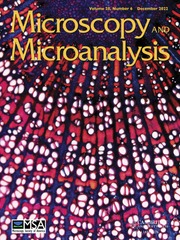Article contents
Direct Observation of Cationic Ordering in Double Perovskite Sr2FeReO6 Crystals
Published online by Cambridge University Press: 06 August 2013
Abstract
Two kinds of Sr2FeReO6 (SFRO) samples, pristine SFRO and Re-excess SFRO, were prepared and we visualized the local atomic structure in terms of cationic ordering in the prepared SFRO samples via high-angle annular dark-field (HAADF) scanning transmission electron microscopy (STEM). HAADF-STEM results demonstrated the high degree of cationic ordering maintains in both the pristine SFRO and Re-excess SFRO samples. On the other hand, defective structures such as antiphase boundary and Re-deficient phase were observed dominantly in the pristine SFRO, and thus the poor magnetic property in the pristine SFRO is attributed to those defective structures related with the frustrated Fe/Re ordering.
Keywords
- Type
- Research Article
- Information
- Copyright
- Copyright © Microscopy Society of America 2013
References
- 7
- Cited by


